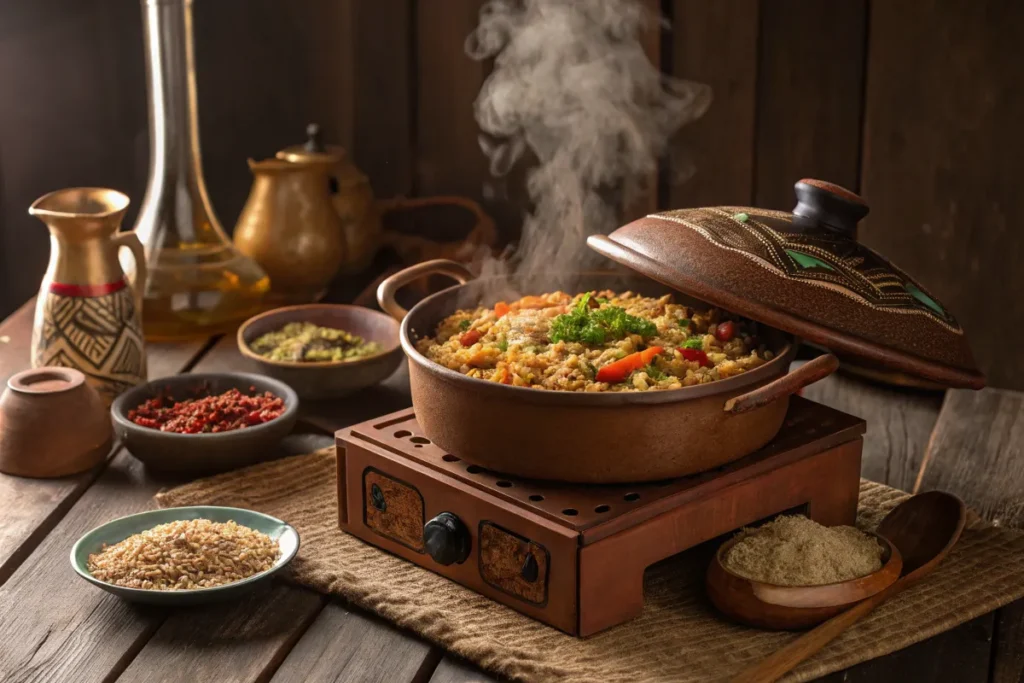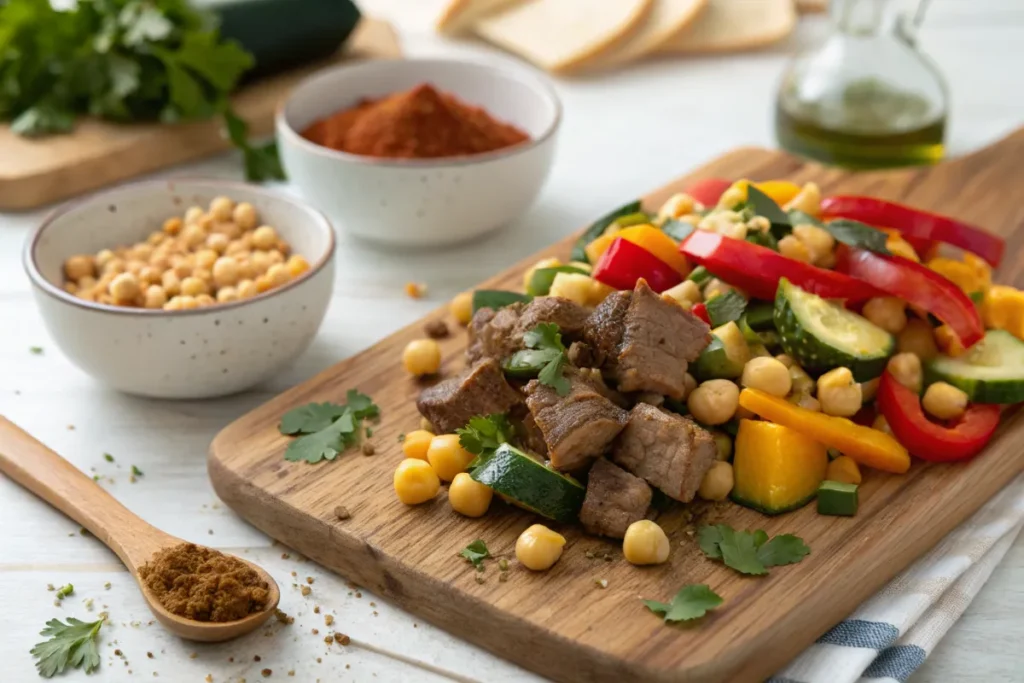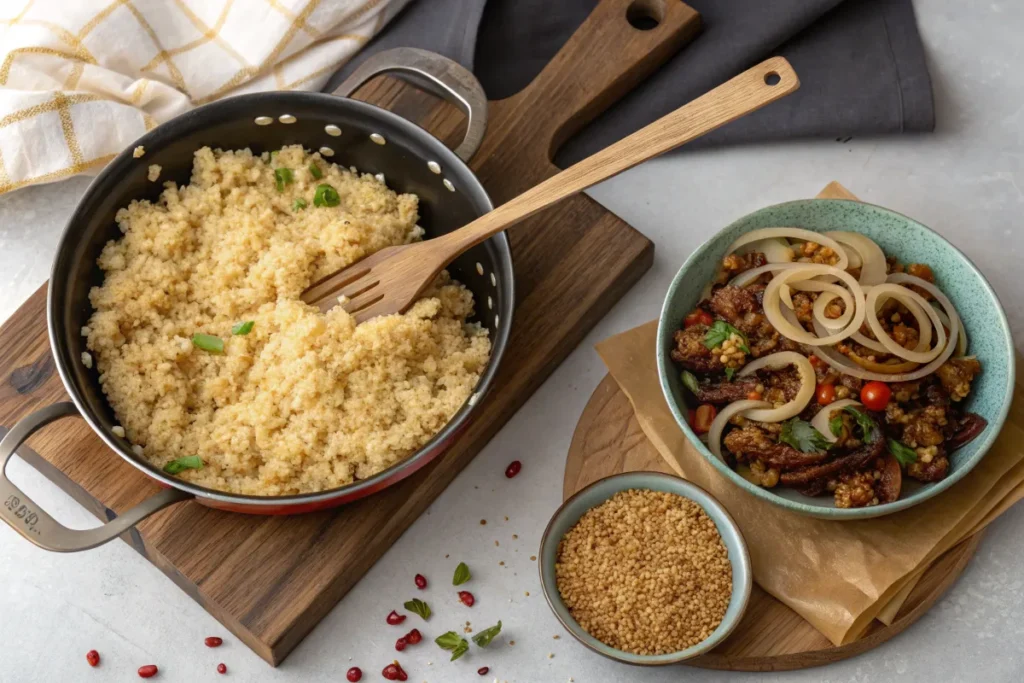Ever stumbled across a dish that instantly made you feel warm, welcomed, and hungry all at once? That’s exactly what the Terra Massoud recipe brings to the table. This isn’t just a meal—it’s a story. One rich with culture, flavor, and heart. Whether you’re a seasoned foodie or just someone curious about exploring global flavors, this guide walks you through everything you need to know.
In this article, we’ll dive deep into what makes the Terra Massoud recipe so special. From its cultural roots to the must-have ingredients, from step-by-step cooking instructions to serving tips, this comprehensive guide has you covered. You’ll also find helpful FAQs, nutritional insights, and even some modern variations to try. And guess what? By the end, you might just feel confident enough to whip it up like a pro.
So grab your apron—this flavorful journey is just getting started.
Introduction to Terra Massoud
Origins and Cultural Significance of Terra Massoud

To truly appreciate the Terra Massoud recipe, we’ve got to take a step back—way back. While the exact origin is still debated, many believe this savory dish has deep roots in Middle Eastern or Mediterranean kitchens. Richly spiced, layered with flavor, and centered around slow-cooked meats or hearty grains, Terra Massoud isn’t just food—it’s tradition served on a plate.
For generations, it’s been the centerpiece of family feasts, religious celebrations, and neighborhood gatherings. It symbolizes abundance, warmth, and the joy of sharing a meal with those you love. In many homes, it’s not uncommon for the recipe to be passed down from grandmothers to grandchildren—each version carrying a unique spin or secret ingredient.
In essence, it’s more than a recipe. It’s a bridge between the past and present, carrying stories, love, and community in every bite.
Understanding the Popularity of Terra Massoud Recipes
Lately, the Terra Massoud recipe has made its way into the hearts (and kitchens) of food lovers around the world. Why? Because it’s the perfect blend of comfort and complexity. It’s hearty enough to satisfy, yet versatile enough to impress.
With the rise of global cuisines and adventurous palates, dishes like Terra Massoud are enjoying their moment in the spotlight. Food bloggers are obsessed. Chefs are reimagining it. Home cooks are swapping out ingredients and making it their own. Thanks to this boom in culinary curiosity, people are discovering how simple, nourishing, and soul-satisfying a dish like Terra Massoud can be.
Plus, let’s not ignore the obvious: it just tastes amazing. The fusion of bold spices, tender meats or veggies, and perfectly cooked grains makes it irresistible. And hey, once you’ve had it, you’ll understand exactly why everyone’s raving about this savory staple.
Essential Ingredients for Terra Massoud

Core Components of the Traditional Terra Massoud Recipe
Diving into the heart of the Terra Massoud recipe, it’s evident that the magic lies in its ingredients. Each component plays a pivotal role in crafting the dish’s signature taste and texture. Let’s break down these essentials:
- Looking for other nutrient-packed Mediterranean options? Check out our Mediterranean Quinoa Power Bowl for another flavor-rich grain-based dish. offering a nutty flavor and delightful chewiness. However, variations might incorporate couscous, quinoa, or rice, depending on regional preferences or dietary needs.
- Protein: Lamb or chicken are the go-to choices, infusing the dish with rich, savory notes. For those exploring plant-based options, chickpeas or tofu can seamlessly step in, providing both texture and protein.
- Vegetables: A medley of zucchini, bell peppers, cherry tomatoes, eggplant, and butternut squash not only adds vibrant colors but also layers of flavor and nutrition.
- Legumes: Chickpeas often make an appearance, enhancing the dish’s heartiness and nutritional profile.
- Aromatic Spices: The soul of Terra Massoud lies in its spice blend. Cumin, coriander, cinnamon, and paprika come together to create a warm, inviting aroma that’s unmistakably characteristic of this dish.
Selecting Quality Ingredients for Optimal Flavor
The journey to an exceptional Terra Massoud begins long before the cooking process—it’s rooted in the selection of top-notch ingredients. Here’s how to ensure each element shines:
- Grains: Opt for whole grains that are fresh and free from any signs of moisture or pests. Their freshness directly impacts the dish’s texture and flavor.
- Protein: If using meat, prioritize cuts that are fresh, preferably from grass-fed or free-range sources. For plant-based proteins, ensure they’re organic and minimally processed.
- Vegetables: Seasonal, organic produce not only tastes better but also retains more nutrients. Visit local farmers’ markets or trusted grocers to source the freshest picks.
- Spices: Invest in whole spices when possible, grinding them just before use. This practice unlocks their full aromatic potential, elevating the dish’s overall flavor profile.
Substitutions and Dietary Adaptations
One of the beauties of the Terra Massoud recipe is its adaptability. Whether catering to dietary restrictions or simply experimenting, here are some thoughtful substitutions:
- Grains: For a gluten-free version, swap bulgur with quinoa or rice.
- Protein: For another plant-based meal with bold spices and roasted veggies, our Roasted Stuffed Bell Peppers recipe is worth a try. lentils, or marinated tofu.
- Spices: Adjust the spice levels to suit your palate. If you’re sensitive to heat, reduce the paprika; if you crave more warmth, a pinch of chili flakes can do the trick.
- Add-ins: Incorporate nuts like almonds or pine nuts for added crunch, or introduce dried fruits like apricots for a hint of sweetness.
Remember, the essence of Terra Massoud lies in its harmonious blend of flavors and textures. By thoughtfully selecting and adapting ingredients, you can craft a version that’s uniquely yours while still honoring the dish’s rich heritage.
Step-by-Step Preparation of Terra Massoud
Preparing the Protein: Techniques and Tips
The protein component serves as the backbone of the Terra Massoud recipe, setting the stage for a flavorful experience. Here’s how to approach it:
- Marination: Begin by seasoning your chosen protein—be it lamb, chicken, or a plant-based alternative—with salt, black pepper, and a blend of spices like turmeric, cinnamon, and cardamom. Allow it to marinate for at least 30 minutes. This step infuses the protein with deep flavors and tenderizes it.
- Cooking: In a large pot, heat olive oil over medium heat. Add the marinated protein, searing it on all sides until browned. This caramelization locks in juices and builds a rich flavor foundation. For meats, ensure they’re cooked through yet remain tender; for plant-based options, aim for a firm yet yielding texture.
Cooking the Grains: Achieving Perfect Texture

Grains provide the comforting base of Terra Massoud, and their preparation is crucial:
- Rinsing: Before cooking, rinse grains like bulgur or rice under cold water until the water runs clear. This process removes excess starch, preventing clumpiness.
- Toasting: For an added depth of flavor, lightly toast the grains in a dry pan over medium heat until they emit a nutty aroma.
- Cooking: Combine the grains with a suitable liquid—chicken or vegetable stock enhances flavor. Use a ratio of approximately 2 parts liquid to 1 part grain. Bring to a boil, then reduce to a simmer, covering the pot. Cook until the grains are tender yet retain a slight bite, absorbing the liquid fully.
Layering Flavors: Sautéing Aromatics and Spices
The soul of Terra Massoud lies in its aromatic layers:
- Aromatics: In the same pot used for the protein, add finely chopped onions and sauté until they turn golden brown. Introduce minced garlic, cooking until fragrant but not browned to avoid bitterness.
- Spices: Sprinkle in your spice blend—cumin, coriander, cinnamon, and paprika. Stir continuously for about 30 seconds, allowing the spices to toast and release their essential oils. This blooming process intensifies their flavors, permeating the dish with warmth and complexity.
Combining Components: Assembling the Dish
Bringing all elements together harmoniously is the final act:
- Integration: Return the cooked protein to the pot with the sautéed aromatics and spices. Stir to ensure the protein is well-coated with the flavorful mixture.
- Vegetables and Legumes: Add your selection of chopped vegetables and legumes like chickpeas. Pour in additional stock if needed, ensuring all ingredients are adequately moistened.
- Simmering: Cover the pot and let the mixture simmer gently, allowing the flavors to meld. Stir occasionally, checking for seasoning and adding salt or pepper as desired.
- Final Touches: Once everything is tender and the flavors have married beautifully, remove from heat. Let the dish rest for
Variations of the Terra Massoud Recipe
Regional Interpretations and Twists
The Terra Massoud recipe has journeyed across various regions, each adding its unique flair to this beloved dish. Let’s explore some of these regional adaptations:
- Middle Eastern Influence: In parts of the Middle East, Terra Massoud incorporates aromatic spices like cumin and coriander, enhancing its depth of flavor. Some versions also include dried fruits such as apricots or raisins, adding a subtle sweetness that complements the savory elements.
- Mediterranean Touch: Mediterranean adaptations often feature a generous use of olive oil and fresh herbs like oregano and basil. Sun-dried tomatoes and olives might be added, infusing the dish with the region’s signature flavors.
- North African Variation: In North Africa, particularly Morocco, Terra Massoud is spiced with blends like ras el hanout, giving it a warm, complex profile. The inclusion of preserved lemons and almonds provides a tangy and nutty twist.
Modern Takes on the Classic Terra Massoud Recipe
Contemporary chefs and home cooks alike have embraced the versatility of the Terra Massoud recipe, experimenting with innovative ingredients and techniques:
- Vegetarian and Vegan Options: Replacing meat with plant-based proteins such as chickpeas, lentils, or tofu caters to vegetarian and vegan diets without compromising on texture or flavor.
- Grain Alternatives: For those seeking gluten-free options, substituting traditional grains with quinoa or cauliflower rice offers a suitable alternative while maintaining the dish’s hearty nature.
- Curious about fusion dishes? These Thai Coconut Curry Mussels show how global flavors can meet in one bowl. like adding coconut milk for a creamy texture or using Asian-inspired spices, introduces a fusion twist that appeals to adventurous palates.
- Deconstructed Presentation: Modern plating techniques involve serving the components of Terra Massoud separately, allowing diners to appreciate each element individually before combining them to their liking.
These variations not only showcase the adaptability of the Terra Massoud recipe but also invite cooks to personalize the dish, making it a canvas for culinary creativity.
Serving and Pairing Suggestions
Ideal Accompaniments for Terra Massoud
To elevate the Terra Massoud recipe experience, consider pairing it with complementary sides and beverages:
- Classic Accompaniments:
- Steamed Rice or Quinoa: These grains absorb the rich flavors of Terra Massoud, providing a balanced and satisfying meal.
- Flatbread or Pita: Perfect for scooping up the savory mixture, adding a delightful textural contrast.
- Low-Carb Alternatives:
- Cauliflower Rice: A lighter option that mirrors the texture of traditional grains without the extra carbohydrates.
- Zucchini Noodles: Introduce a fresh, nutrient-dense component that complements the dish’s robust flavors.
- Bright Salads:
- Simple Tomato-Cucumber Salad: A refreshing side that adds a crisp contrast to the hearty Terra Massoud.
Presentation Tips for an Appealing Meal
The visual appeal of a dish enhances the dining experience. Here are some tips to present your Terra Massoud recipe attractively:
- Color Contrast: Garnish with fresh herbs like parsley or cilantro to introduce a pop of color against the rich tones of the dish.
- Texture Variation: Sprinkle toasted nuts or seeds on top for added crunch and visual interest.
- Plating: Serve in a wide, shallow bowl to showcase the layers and ingredients, making the dish inviting and appetizing.
By thoughtfully selecting accompaniments and focusing on presentation, you can transform the Terra Massoud recipe into a memorable culinary experience that delights both the palate and the eyes.
For more delicious recipes, check out our recipe article.
Common Mistakes and Troubleshooting
Avoiding Pitfalls in Preparation
Even the best cooks sometimes run into snags. But when it comes to the Terra Massoud recipe, most issues are totally avoidable with a little know-how. One of the biggest mistakes? Overcooking the grains. When grains are mushy, they lose their texture and make the dish feel heavy. To avoid this, always watch your cooking time and use the right liquid ratio.
Another common pitfall is skimping on the spices. Since this dish thrives on deep, layered flavors, using too little spice can leave it tasting flat. Always toast your spices briefly to unlock their full aroma before adding them to the dish.
Lastly, overcrowding the pot with veggies or protein can make it soggy instead of savory. Give each component enough room to cook properly.
Solutions for Common Cooking Challenges
If your Terra Massoud recipe turns out bland, don’t worry—it’s fixable. Try a quick flavor boost with a splash of lemon juice, fresh herbs, or a pinch more spice. That small tweak can make a big difference.
For dry grains, gently steam them with a bit of broth. On the other hand, if the dish ends up watery, simmer uncovered until the liquid reduces. With a few simple adjustments, you’ll be back on track in no time.
Nutritional Information and Health Benefits
Caloric and Nutritional Breakdown of Terra Massoud
Let’s talk health! One of the reasons the Terra Massoud recipe has gained popularity is that it’s both filling and nutritious. A typical serving—depending on ingredients—comes in at around 350–500 calories. Most of those come from lean protein, slow-digesting grains, and fiber-rich vegetables.
The balance of macronutrients makes it a great option for anyone looking to eat healthier without sacrificing flavor. You get a healthy dose of protein, complex carbs, and good fats, especially if olive oil and nuts are part of your mix.
Health Benefits of Key Ingredients
What makes the Terra Massoud recipe even more appealing is its lineup of health-friendly ingredients. For example:
- Bulgur and quinoa provide fiber and help maintain stable blood sugar.
- Chickpeas and other legumes are packed with plant-based protein and support heart health.
- Olive oil, rich in healthy fats, can reduce inflammation and boost brain function.
- Spices like turmeric and cumin aren’t just tasty—they also have antioxidant and anti-inflammatory properties.
All in all, it’s a dish that nourishes both the body and the soul. So, when you serve up Terra Massoud, you’re doing your taste buds—and your health—a real favor.
Frequently Asked Questions (FAQs)
Can I make Terra Massoud ahead of time?
Absolutely! In fact, many say the Terra Massoud recipe tastes even better the next day. Letting the flavors rest overnight helps everything blend beautifully. Just store it in an airtight container in the fridge and reheat it gently over the stove or in the microwave when you’re ready to serve. Add a splash of broth or water to keep it moist.
What are the best storage methods for Terra Massoud?
To keep your Terra Massoud recipe fresh, always store it in a sealed container. It will stay good in the fridge for up to four days. If you want to freeze it, let it cool completely first. Then, place it in a freezer-safe container or zip-top bag. It can last in the freezer for up to a month. Thaw it in the fridge overnight before reheating.
Are there vegetarian alternatives for Terra Massoud?
Yes, there are! One of the best parts about the Terra Massoud recipe is how easy it is to adapt. Swap out the meat for hearty plant-based options like chickpeas, lentils, tofu, or even mushrooms. These give the dish the same satisfying texture and deep flavor when seasoned well.
How can I adjust the spice level to my preference?
If you’re not into spicy food, don’t worry—you’re in control here. Simply reduce the amount of paprika or chili flakes. Want to crank it up? Add a pinch of cayenne or a chopped hot pepper. Taste as you go, and remember, it’s always easier to add more heat than to take it away.
Conclusion and Encouragement to Experiment
Embracing Creativity in Your Terra Massoud Journey
Now that you’ve explored every layer of the Terra Massoud recipe, it’s your turn to bring it to life. Don’t be afraid to experiment with ingredients and flavors. Cooking is part science, part art, and this dish is the perfect canvas to express both. Whether you’re sticking to the traditional version or putting your own twist on it, remember—it’s all about making it yours.
You might add roasted veggies one day, switch up the grains the next, or toss in some nuts or fruits for a unique spin. The options are endless, and every tweak adds a personal touch.
Sharing Your Culinary Creations
Once you’ve nailed your perfect Terra Massoud recipe, don’t keep it to yourself. Share it with friends, post it on social media, or bring it to your next potluck. Great food is meant to be shared, after all!
And if you’re looking for more delicious meals like this one, be sure to check out the other unique recipes on our website. You never know what dish might become your new favorite. Keep cooking, keep experimenting, and most of all—enjoy every bite!

